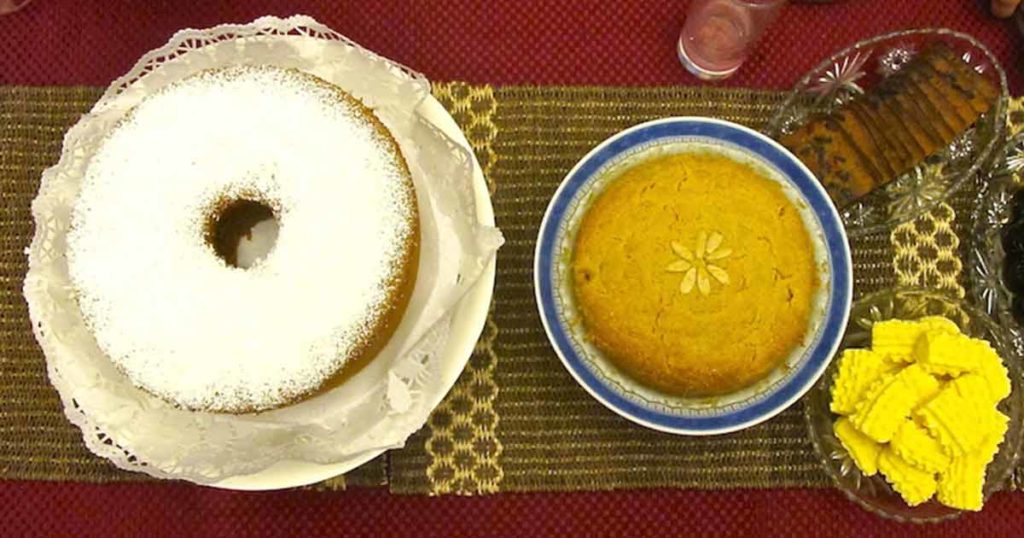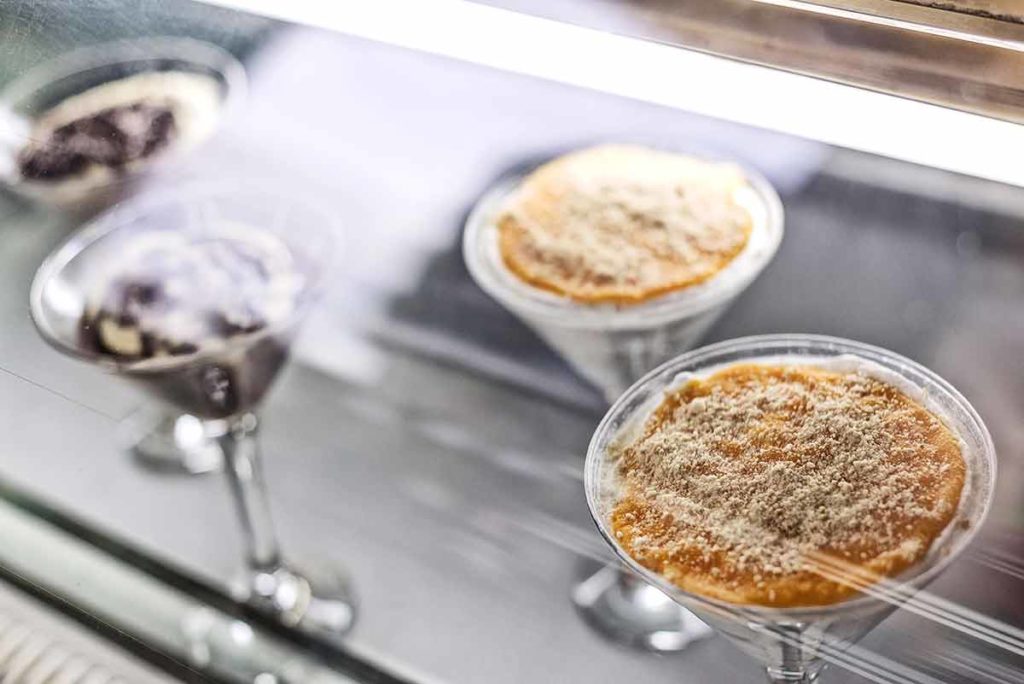As a UNESCO Creative City of Gastronomy, Macao is also home to a plethora of desserts for those with a sweet tooth. While many visitors go in search of Lord Stow’s Portuguese egg tart or Serradura – both Portuguese desserts – they miss out on traditional authentic Macanese desserts, whose flavour profiles and texture consistencies are more similar to Indonesian and Malay cakes.
Macanese cuisine has its roots in Portuguese cuisine but is heavily influenced by Asian flavours. A few ingredients feature heavily in Macanese desserts: egg yolks, coconut, almonds, butter, and glutinous rice flour.
Great ideas to help you plan your trip to Macao:
- 50 free things to do in Macau
- 18 Incredible Macao Landmarks For Your Bucket List
- 20 Places To Visit in Macao
- Macao With Kids
- Where To Stay In Macao
- How To Do A Macao Day Trip From Hong Kong
Contents
Macanese desserts

Historical anecdotes link the heavy use of egg yolks in desserts because the nuns needed egg whites to starch their habits and had to find a use for the yolks.
The rich flavours of butter come from Macao’s Portuguese legacy while coconut and glutinous rice flour – ingredients used across Southeast Asia in desserts are a result of the Portuguese trade bringing together produce across their colonies from Melaka to India and Africa.
Fortunately, Macao has many excellent Chinese, Macanese and Portuguese restaurants, where you can try Portuguese and Macanese desserts.
Baji

The easiest Macanese dessert to attempt at home is probably the Baji – made with pulu (glutinous) rice, sugar, and grated coconut.
Baji is made of three simple ingredients: glutinous rice, sugar and grated coconut.
It is derived from the Malay glutinous rice dessert Wajek and the Macanese’s answer to Europe’s “creamy sweet rice”, or the Portuguese variation of Arroz Doce.
It’s boiled in coconut milk and sugar is added to the cooked rice.
Alua

According to Macanese chef Florita Alves at La Famiglia restaurant in Taipa village, “Alua is probably the most iconic Macanese dessert.”
Although it is eaten only during Winter, it has a very special flavour.
Alua (baby Jesus’ mattress) is eaten mostly during Christmas time in Macao (Christmas is also one of the best times to visit Macao for a celebration).
It is a dessert made with pulu (glutinous) rice flour, coconut, jagra (brown cane sugar), almonds, pine nuts and a generous amount of butter (or lard).
With a similar texture and consistency to Indonesian and Malay Kuihs (cakes).
Originally from Goa where the dessert shares the same name, the Goan version is made with wheat flour, chopped almonds and ghee.
It is one of the three Christmas sweet treats that best symbolise the Christian faith in Macao.
Coscurao
The other two Coscurao (baby Jesus’ blanket) and Farte (baby Jesus pillow) make up the holy trinity of desserts.
You will find the Coscurao on the dessert menus across the South China Guangdong region, known as “windmills” in Chinese given their shape – deep-fried dough sheets sprinkled with sugar syrup or molasses.
Bolo Menino

The Bolo Menino meaning “little boy’s cake” is only found in Macao and not in Portugal or Brazil despite its Portuguese name.
The sponge cake’s origin is not known.
Its key ingredients are butter, coconut, 12 egg yolks, six egg whites, roasted bean flour, and sugar.
A key sweet treat at parties, it is said to be created to honour baby Jesus as it is seen mostly during Christmas and other celebratory occasions in Macao.
The Macanese always celebrated religious Catholic and Christian holidays with a feast.
The Portuguese are said to have brought potatoes to the Far East.
Batatada
A popular Macanese dessert is the Batatada, a potato pudding now made with sweet potatoes or yam (historically made with potatoes) mixed with coconut, butter, and egg yolks.
There are many variations to this recipe.
Bebinca

Bebinca is a versatile dessert that’s popular on Macanese restaurant menus and found across the rest of Southeast Asia.
Of Malay origin and known as Bingka in Malay, the Macanese recipe uses the same recipe featuring coconut and rice flour features in the pudding.
On the streets of Manila, you can find Bebingka or Bebincam – small cakes made of rice flour, sugar, eggs, and coconut with one side of it cooked over the charcoal fire.
In Goa, Malaysia, Singapore, Thailand and Indonesia, Bebinca is a multi-layered cake (also known as Kuih Lapis) that is baked in layers – a tedious amount of work.
Genetes

Genetes are simple buttery cornstarch biscuits – the airy powdery texture melts in your mouth.
The Macanese’s genetes are the perfect snack accompaniment to your afternoon coffee.
Often confused with each other Bicho Bicho meaning little bugs is pan-fried dough (instead of baked in the oven) and dipped in caramelised sugar.
You can find also find bicho bicho in the Philippines and it’s said to have been introduced by the Chinese, but is a smaller sweet variant of the youtiao, deep-fried crispy Chinese dough sticks.

Portuguese Desserts
Serradura

Finally, there are the classical Portuguese desserts that have stuck on the menu of restaurants across Portuguese colonies like Serradura “sawdust” pudding popular in Macao and Goa and a fluffy rich chocolate mousse.
Serradura means sawdust in Portuguese – its name derived from the texture of crumbled Marie biscuits.
The rich dessert is served in a glass cup with alternate layers of whipped cream, condensed milk and crumbled Marie biscuit.
The repertoire of desserts in Macao is rich and colourful.
Whatever tickles your fancy, don’t leave Macao without trying at least one traditional dessert – the rich, robust flavours that carry the tales of Portuguese adventures through their colonies.

Serradura
A classic Portuguese dessert served in cafes and restaurants in Macau that is simple to make.
Ingredients
- 200 g Marie biscuits
- 250 ml whipping cream
- 125 ml condensed milk
- 1/2 teaspoon vanilla extract
Instructions
- Place the Marie biscuits in a food processor and ground until they become biscuit crumble.
- Use an egg beater to beat the cream until it thickens then add condensed milk and vanilla extract and mix well.
- Prepare a glass or bowl by placing a layer of crumble at the bottom of the glass.
- Add a layer of whipped cream, then a layer of crumble and continue building up the Serradura pudding in layers until the glass is full.
- Place the serving glasses in the refrigerator for two hours before serving.
Notes
Instead of a food processor, you can place the biscuits in a zip-lock bag and beat the biscuits with a rolling pin.
Nutrition Information
Yield 2 Serving Size 2Amount Per Serving Calories 1044Total Fat 69gSaturated Fat 38gTrans Fat 2gUnsaturated Fat 27gCholesterol 173mgSodium 717mgCarbohydrates 92gFiber 2gSugar 50gProtein 17g
Plan Your Trip

Rent A Car – Find the best car rental rates at Discover Cars. They compare car hire companies to provide you with the best deal right now.

Find A Hotel – If you’re curious about this article and are looking for somewhere to stay, take a look at these amazing hotels.






